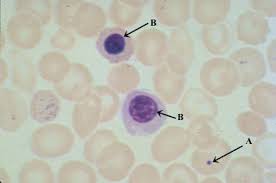 Nucleated RBCs are red blood cells with a nucleus.
Nucleated RBCs are red blood cells with a nucleus.
The nucleus, which contains DNA, should eject naturally as the cell develops in the bone marrow.
When the nucleus has dissolved, the cell becomes more flexible.
It will squeeze out of portholes in the bone marrow and enter the bloodstream.
The empty space in the cell then fills up with hemoglobin.
The presence of nucleated RBCs can indicate a number of diseases or blood conditions, such as leukemia, anemia, or problems with the spleen.
An elevated nucleated RBC might suggest that the body is producing RBCs outside of the bone marrow.
Alternatively, it could indicate that there is damage to the blood-bone barrier, allowing these immature cells to escape from the marrow.
The normal reference range for nucleated red blood cell is 0.
Humans more than a few days old should not have any nucleated RBC in their bloodstream whatsoever.
Nucleated RBC are counted by the number of RBC per white blood cell (WBC).
A normal nucleated RBC reference range for adults and children is a count of 0 nucleated RBC/100 WBC.
The presence of only a few nucleated red blood cells can indicate serious health issues.
The only time nucleated RBC is normal in humans is in infants for up to five days after birth: especially if they have growth issues or have experienced a lack of oxygen.
Normoblastemia can be caused by several blood diseases and health conditions:
Bone marrow damage including blood cancers such as leukemia and lymphoma, tuberculosis, and certain fungal infections.
RBC production outside of the bone marrow, extramedullary hematopoiesis: include leukemia, myeloid metaplasia and polycythemia vera.
Spleen dysfunction certain types of anemia, malaria, collagen vascular diseases, malignant neoplasms, and chemotherapy treatment.
Normoblastemia can be a sign of splenic failure.
Hypoxia
